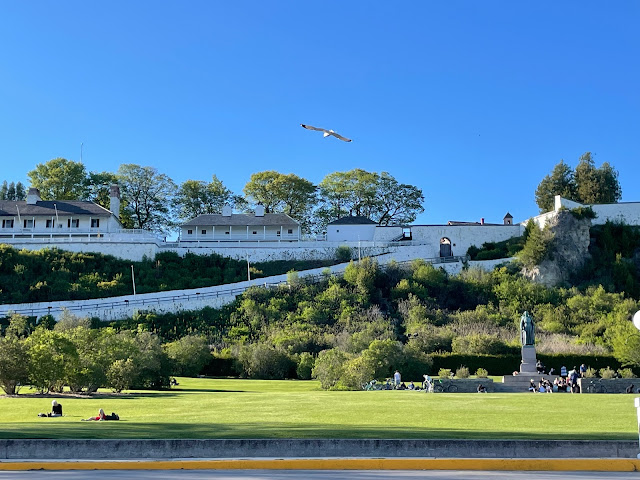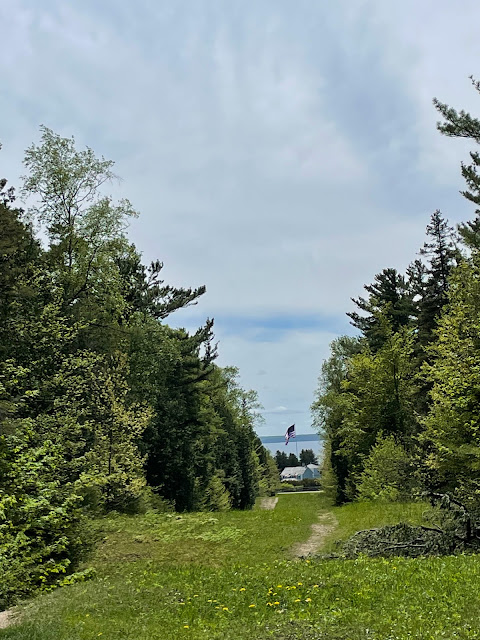Day tour of Mackinac Island
During my family's trip to Michigan, we had the opportunity to visit Mackinac Island, one of the USA's "summer colonies" that have what Filipinos call bahay bakasyunan. Mackinac Island is found where Lake Huron and Lake Michigan meet (at the Straits of Mackinac). These lakes are members of the Laurentian Great Lakes.
Ninang Trining really wanted us to see Mackinac Island and after a day of touring the island, I can understand why. It is steeped in history pre-dating the existence of the USA, has beautiful architecture and landscapes, and provides a glimpse at what life must be like when motor vehicles haven't dominated the roads.
The first European settlers were fur traders and Catholic missionaries. In this way, the Europeans built strong relationships with the indigenous peoples who arrived on the island before the Europeans did. Back in 18th century, the French and the British colonials empires were vying for territory; thus, both empires built forts. Fort Mackinac was built by the British on the island itself; the French built Fort Michilimackinac on Michigan's lower peninsula (in what is now Mackinaw City).

Though there were several territorial conflicts that saw the island change hands from the French to the British, and then to the Americans. While listening to our tour guide talk about the island's history, I became fascinated by how it is affected by the events happening worlds away: the French Indian War was the North American theatre of the Seven Years War between France and the British Empire; the War of 1812 was, I think, a continuation of the American Revolutionary War (since the USA was trying to kick out the British from its occupied areas in North America).
The byproduct of such an extended stay of Europeans on the island is the architecture. The Catholic Church of Ste Anne was built in the late 19th century. It was established by Jesuit missionaries to serve the spiritual needs of indigenous peoples who converted to Catholicism and French immigrants. The church features Carpenter Gothic and Gothic Revival architectural details like the tall and narrow windows and the steep roof. It also appears to have Italian architectural details like pinnacles (pyramid-like structure topping the belltower, cornices, and pediments above doors.

On the other hand, Mackinac Island's Grand Hotel. It has a commanding presence seen from the ferry boat, designed to cause first-timers to be wowed at the sight. Like the Ste Anne Church, the hotel is made of wood. The hotel's signature is its long porch, which is the longest porch in the world. The hotel is an example of a mix of Queen Anne architecture (presence of such a prominent porch) and American Colonial Revivalism.

I was quite surprised to find my second Statue of Liberty on Mackinac Island (the first one was in Odaiba). It's found staring outwards towards the water along Main Street.

Mackinac Island also features simpler constructions that show visitors what life must have been like when the European settlers first landed. The Missionary Bark Chapel on Marquette Park, for instance, is a replica of the structure that Jesuits used as a church. It actually gave me an image of how difficult life is like for missionaries in foreign lands; I didn't grasp it as deeply previously.
My son, obviously, enjoyed visiting the chapel... more like he enjoyed picking rocks by the church's front door.

Mackinac Island also has some interesting geologic features like the Arch Rock, which is found in the Mackinac State Park. This rock formation is found on the shores of Lake Huron and was formed when the glaciers melted thousands of years ago. The first settlers believed that the Arch Rock is a significant spiritual place.

Within the state park lies three cemeteries: Ste Anne's Catholic Cemetery and Mackinac Island Cemetery, where former civilian residents of the island are buried; and Post Cemetery, a military cemetery where soldiers from the War of 1812 (and veterans of other wars, and eligible relatives) are buried. In the middle of the island, these cemeteries provide a peaceful and quiet break from the noise and fast pace of the downtown area.

The fourth cemetery is technically not a cemetery; rather it's a sacred burial site called Skull Cave. It was discovered by a European fur trader who sought shelter in the island during a war in the 18th century. Right across skull cave is a downward incline that is made of rolling terrain. Snipers used to practise in this location.

The horse-drawn carriages that transported people from Point A to Point B made our day trip possible; the stories narrated by the tour guides about the island's different spots provided more insight into this very interesting island. Unfortunately, strollers were not allowed in the carriages, so I had to either let the wee one run around or carry him (when he got exhausted).

Mackinac Island is such an intriguing location. I'd like to return and explore it a bit more someday. Definitely when the wee one is older and can appreciate the island's history more.

Comments
Post a Comment
Thank you for dropping by!
Before moving on, please share your thoughts or comments about the post. :)
Thanks again!